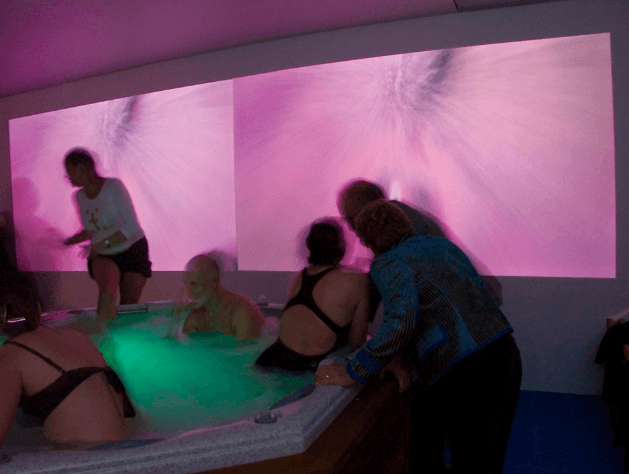By Andrew Clifford
Review of the exhibition Wet Social Sculpture by Stella Brennan. Exhibited at St Paul St Gallery, 20 October – 12 November 2005.
After opening an exhibition, most artists are usually worn out from frantic last-minute preparations, working the room and then the obligatory late dinner out.
The morning after opening Wet Social Sculpture at AUT’s St Paul St Gallery, Stella Brennan claims to feel refreshed. Not surprising, considering she spent most of the previous evening in an eight-seater spa pool – the star attraction of her exhibition – and will field questions from the same vantage point.
Brennan also teaches at AUT’s School of Art and Design so she is on home turf. She chats happily to students who curiously drop by or want a pre-lecture dip.
She hopes the sociable campus setting will result in more people donning togs to interact with her installation, although she also considered installing it at Starkwhite, her dealer gallery that once had its own spa in its previous incarnation as K Rd’s Pink Pussycat strip club.
“Students are much more inclined to get in there and give things a go than necessarily the general public,“ she says. “If it was at Starkwhite there probably would be people using it, but if it had been somewhere like the Auckland Art Gallery I’m not entirely confident that people would feel comfortable coming in and doing that.“
Wet Social Sculpture takes its inspiration from the late German artist Joseph Beuys, who declared that “everyone is an artist“ and coined the term social sculpture with a community-focused tree-planting project.
“Beuys was a real touchstone in thinking about where the boundary of art practice is and who has the licence to do that.
“I am always thinking about that in terms of bowling up to people who don’t necessarily have much of an understanding of the context of contemporary art and asking them to be very generous with all these different kinds of things,“ she says, referring to the companies which have supplied products for her exhibitions.
“As an artist you make an assumption that art is something important that everyone wants to have around, but it is middle-class privilege, I guess.
“We are bobbing around in middle-class privilege right now so it’s definitely something I was thinking about in terms of who are the people who have the leisure and the time and the interest to pursue this kind of stuff.
“As a producer, where are you located socially and as a consumer?“
Borrowing the materials for her exhibitions, which entailed filling Starkwhite with rental plants, may have interesting conceptual implications but the strategy was born of pragmatism.
“It initially was a kind of response to economical and ecological disquiet about making these big, expensive things. I didn’t feel that, for my ideas and my practice, it was justifiable to make these things that then just sit around in my garage or under my parents’ house or maybe in [Starkwhite’s] back room.
“I just started to see myself disappearing under piles of polystyrene and curious stuff I found in the inorganic.“
By working this way, Brennan can shift the focus from the objects to the way we interact with them.
“I am interested in objects but I’m interested in the narrative of objects or the space they inhabit, rather than necessarily having and holding things. A lot of objects out there have a sort of peripatetic existence.
“I think the hire plants are a real one. It was like something that was a living thing that really doesn’t have any location except to soften, beautify and humanise these kinds of public and semi-public spaces.“
While sitting in the spa pool, participants can watch a slowed-down sequence from the 1980 film Altered States, accompanied by the sounds of humpback whales.
Brennan describes the projection as “a minute of starbursts, protoplasm, seething cells and opalescent clouds; an abstract interlude in an otherwise more or less conventional Hollywood storyline“.
The film is based on the research of John Cunningham Lilly, whose interest in consciousness led to him investigating dolphin communication and psychedelic drugs, and working as an adviser to George Lucas.
Like the star-gate sequence from 2001: A Space Odyssey, it is a key example of experimental cinema crossing into popular culture.
With the abstract imagery of experimental films, research from the likes of Lilly and associates such as Timothy Leary were later translated into the immersive environments of multimedia music shows, and then into the domestic trappings of hippie culture with lava lamps, New Age therapy and now screen savers.
Brennan wants to take the experiment home and make it a suburban fantasia.
“I think a lot of it has to do with having moved to the North Shore in the past 12 months,“ she laughs. “It is definitely an accoutrement for a certain kind of lifestyle.“

